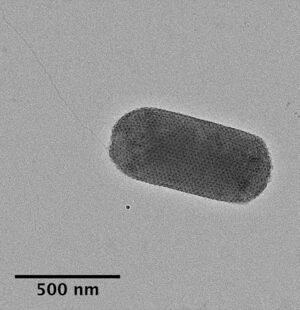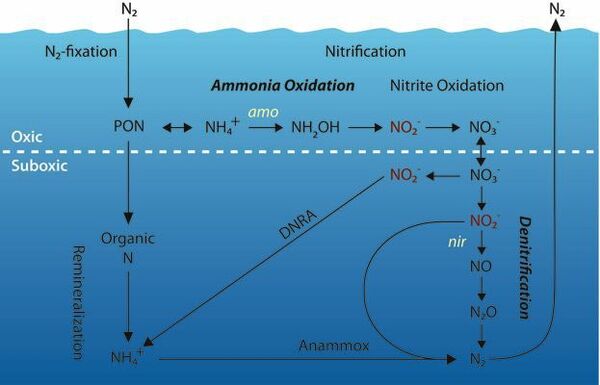Nitrosarchaeum limnium
Classification
Archaea; Thaumarchaeota; Nitrososphaeria; Nitrosopumilales; Nitrosopumilaceae
Species
|
NCBI: [1] |
Candidatus Nitrosarchaeum limnium
Description and Significance
Nitrosarchaeum limnium (formerly Nitrosoarchaeum limnia) is a member of the low-salinity ammonia-oxidizing archaea (AOA), first enriched from sediments in north San Francisco Bay estuary, CA, USA (Blainey et al., 2011; Mosier et al., 2012).
As a member of the ammonia-oxidizing archaea (AOA), N. limnium grows using energy obtained from the oxidation of ammonia (NH4+) to nitrite (NO2-), the first step in nitrification. This process is a critical step in the global nitrogen cycle (Francis et al., 2007), as buildup of ammonia in environments can lead to eutrophication and other consequences.
Genome Structure
As with other microorganisms, the genome of N. limnium is a single, circular chromosome. Two strains of N. limnium have been enriched, both with sequenced genomes. N. limnium SFB1T is 1.77 Mb in size, while N. limnium BG20's genome is slightly smaller at 1.66 Mb. These genomes are ~83% protein-coding genes (2047 and 1945 protein-coding genes in SFB1 and BG20, respectively) and a GC content of 32.5-32.7%.
Specifically for the two N. limnium strains, SFB1 and BG20 genomes both single-copy full-length 16S, 23S, and 5S rRNA genes (and SFB1 also encodes a 5.8S rRNA gene). They also encode single copies of the amoABC genes that encode the archaeal ammonia monooxygenase (AMO) enzyme that is used for oxidizing ammonia, as well as an archaeal nitrite reductase (nirK) that is thought to play a role in ammonia oxidation also (Kozlowski et al., 2016; Martens-Habbena et al., 2015). These genomes also contain all genes necessary for the thaumarchaeal 3-hydroxypropionate/4-hydroxybutyrate CO2 fixation pathway (Könneke et al., 2014), as well as those required for motility via archaellum and chemotaxis (Blainey et al., 2011; Mosier et al., 2012).
Cell Structure, Metabolism and Life Cycle
As with other members of the Nitrospumilales family, N. limnium cells are small rods and have a crystalline S-layer as their exterior (see image here; alsoTolar et al., 2019). N. limnium is also motile via a single archaeal flagellum, or "archaellum"
Similar to most Thaumarchaeota, N. limnium is a chemolithoautotroph. This organism gains carbon by fixing CO2 via the 3-hydroxypropionate/4-hydroxybutyrate pathway that is modified in thaumarchaea (see Könneke et al., 2014) relative to the pathway described in the crenarchaeote Metallosphaera sedula (Berg et al., 2007). N. limnium uses energy derived from the oxidation of ammonium to fuel this carbon fixation and other metabolic pathways. Ammonia oxidation in the Nitrosopumilales has been shown to be highly sensitive to small concentrations of ammonium in the environment due to an incredibly high substrate affinity (see Martens-Habbena et al., 2009), which is thought to influence their ability to survive in oligotrophic (low-nutrient) environments.
Less is known about specific metabolites produced by N. limnium, though other Thaumarchaeota have been shown to produce ectoine and cobalamin (vitamin B12) that are thought to be important contributions to the overall microbial community (Doxey et al., 2015; Widderich et al., 2016; Heal et al., 2017).
Ecology and Environment
N. limnium was first enriched from the San Francisco Bay estuary, and has been found in numerous low-salinity environments worldwide including rivers, lakes, aquifers, and soils. It is free-living and motile, allowing for response to environmental signals and interactions with other microorganisms within aquatic communities.
In such communities, the ammonia oxidized by N. limnium to nitrite is then available for other microorganisms to take up as a nitrogen source (e.g., phytoplankton) or use in other portions of the nitrogen cycle. This includes nitrite oxidation, which is performed by different guilds of bacteria such as Nitrospira, Nitrospina, Nitrococcus, and Nitrobacter. In systems where anoxic regions border oxic regions (water/sediment interfaces in estuaries, for example), nitrite produced by this organism could also be used as a substrate for anaerobic nitrogen cycle processes including denitrification and anammox.
As ammonia oxidation is the first and rate limiting step of nitrification, it plays an important role in the nitrogen cycle the environment and thus N. limnium is an important contributor to nitrogen biogeochemistry in low-salinity environments.
References
Berg IA, Kockelkorn D, Buckel W, Fuchs G. (2007) A 3-hydroxypropionate/4-hydroxybutyrate autotrophic carbon dioxide assimilation pathway in Archaea. Science 318: 1782-6. https://doi.org/10.1126/science.1149976
Blainey PC, Mosier AC, Potanina A, Francis CA, & Quake SR (2011) Genome of a low-salinity ammonia-oxidizing archaeon determined by single-cell and metagenomic analysis. PLoS One 6: e16626. https://doi.org/10.1371/journal.pone.0016626
Doxey AC, Kurtz DA, Lynch MD, Sauder LA, Neufeld JD (2014) Aquatic metagenomes implicate Thaumarchaeota in global cobalamin production. ISME J 9: 461-71. https://doi.org/10.1038/ismej.2014.142
Francis C, Beman J, Kuypers M (2007) New processes and players in the nitrogen cycle: the microbial ecology of anaerobic and archaeal ammonia oxidation. ISME J 1:19–27 https://doi.org/10.1038/ismej.2007.8
Heal KR, Qin W, Ribalet F, Bertagnolli AD, Coyote-Maestas W, Hmelo LR, Moffett JW, Devol AH, Armbrust EV, Stahl DA, Ingalls AE (2017) Two distinct pools of B12 analogs reveal community interdependencies in the ocean. Proc Natl Acad Sci USA 114: 364-369. https://doi.org10.1073/pnas.1608462114
Könneke M, Schubert DM, Brown PC, Hügler M, Standfest S, Schwander T, Schada von Borzyskowski L, Erb TJ, Stahl DA, Berg IA (2014) Ammonia-oxidizing archaea use the most energy-efficient aerobic pathway for CO2 fixation. Proc Natl Acad Sci USA 111: 8239-44. https://doi.org/10.1073/pnas.1402028111
Martens-Habbena W, Berube PM, Urakawa H, de la Torre JR, Stahl DA (2009) Ammonia oxidation kinetics determine niche separation of nitrifying Archaea and Bacteria. Nature 461: 976-9. https://doi.org/10.1038/nature08465
Martens-Habbena W, Qin W, Horak RE, Urakawa H, Schauer AJ, Moffett JW, Armbrust EV, Ingalls AE, Devol AH, Stahl DA (2015) The production of nitric oxide by marine ammonia-oxidizing archaea and inhibition of archaeal ammonia oxidation by a nitric oxide scavenger. Environ Microbiol 17: 2261-74. https://doi.org/10.1111/1462-2920.12677
Mosier AC, Lund MB, & Francis CA (2012) Ecophysiology of an ammonia-oxidizing archaeon adapted to low-salinity habitats. Environ Microbiol 64: 955–963. https://doi.org/10.1007/s00248-012-0075-1
Ren M, Feng X, Huang Y, Wang H, Hu Z, Clingenpeel S, Swan BK, Fonseca MM, Posada D, Stepanauskas R, Hollibaugh JT, Foster PG, Woyke T, Luo H. (2019) Phylogenomics suggests oxygen availability as a driving force in Thaumarchaeota evolution. ISME J 13: 2150-2161. https://doi.org/10.1038/s41396-019-0418-8
Tolar BB, Mosier AC, Lund MB, & Francis CA (2019) Nitrosarchaeum (gbm01289). In: Bergey’s Manual of Systematics of Archaea and Bacteria, Ed: WB Whitman, John Wiley & Sons: Hoboken, NJ. https://doi.org/10.1002/9781118960608.gbm01289
Widderich N, Czech L, Elling FJ, Konneke M, Stoveken N, Pittelkow M, et al. (2016) Strangers in the archaeal world: osmostressresponsive biosynthesis of ectoine and hydroxyectoine by the marine thaumarchaeon Nitrosopumilus maritimus. Environ Microbiol. 18: 1227–48. https://doi.org/10.1111/1462-2920.13156
Author
Page authored by Prof. Bradley Tolar at UNC Wilmington.


